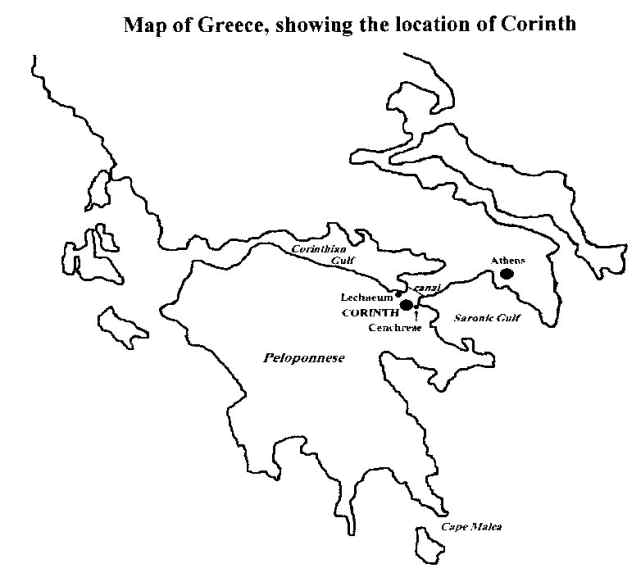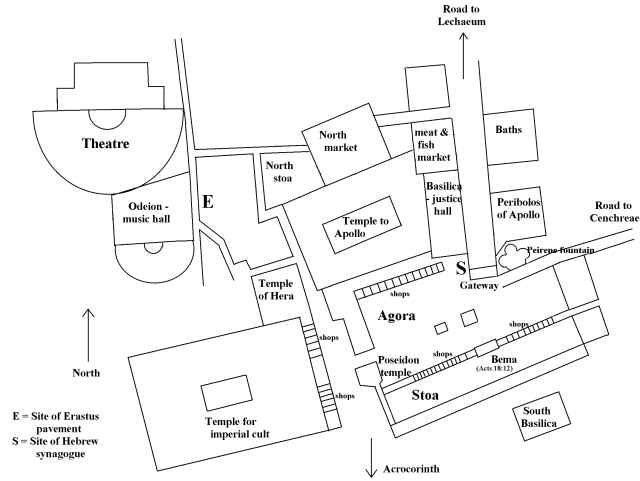Related pages
Geography
At the time of Paul's missionary journeys, Corinth was the leading city of Achaia. Achaia was the Roman province which covered the southern part of the modern nation of Greece. Athens was still the educational centre of Achaia, but Corinth was the capital of the Roman Province and the major commercial centre.
Corinth lay on a narrow isthmus, only six kilometres across, which connected the southern part of the Greek peninsula to the mainland, with sea to the east and west. This strategic position made Corinth one of the richest cities and greatest trading centres of the ancient world. All traffic from Athens and the North of Greece to Sparta and the Peloponnese had to pass through Corinth because of its position on this narrow neck of land.
In addition to the north-south trade, a great proportion of the east to west traffic also passed through Corinth. The three hundred kilometre journey by sea around the southern capes of the Peloponnese was very dangerous and dreaded by sailors. Many sailors said, "Let him who sails round Cape Malea forget his home" (Strabo Geography 8:6:20). Because of this, and to save time, many smaller boats were hauled across the narrow isthmus on rollers. Larger ships were unloaded and the cargo transported by land to ships on the other side. A paved road called the Diolkos (meaning 'to haul across') was built across the isthmus in the sixth century BC. This was six kilometres long, and between three and six metres wide. There were several attempts at cutting a canal across the isthmus. The first was by Alexander the Great. Another attempt by Nero in AD 66 was abandoned after experts told him that the seas on each side were at different levels, so flooding would occur! A canal was finally built in 1893.
Corinth had a strategic location at the foot of the Acrocorinth, a steep, flat topped mountain to the south of the city, that rose up to eight hundred metres. The acropolis was on the top, making it one of the most easily defended strongholds of that time. Corinth lay on a plateau overlooking the isthmus, near to three harbours. The two main harbours were Lechaeum (2 km west) and Cenchreae (12 km east). There was also the little used Schoenus (also to the west). So Corinth was known as the 'two sea'd Corinth'.
Objects of luxury soon found their way to the markets, which were visited by people from every nation in the civilised world: Arabian balsam, Phoenician dates, Libyan ivory, Babylonian carpets, Cilician goat's hair, Lycaonian wool, and Phrygian slaves. Corinth was especially famous for its production of high quality bronze-ware.

History of Corinth
The Phoenicians first settled there, introducing profitable business as well as their worship. Greeks later took control and named the city Corinth. Macedonians held the city from 335 to 197 BC, when the Romans took control, declaring it a free city in 196 BC In 146 BC, it rebelled against Rome and as reprisal, was destroyed by the Roman general Lucius Mummius. He killed all the male population, and sold the women and children into slavery, and took its famous art treasures to Rome, leaving the city in ruins for a hundred years.
Julius Caesar rebuilt it as a Roman Colony in 44 BC, with Latin as its official language. It soon regained prominence, becoming the capital of the Roman province of Achaia in 27 BC. The rapid growth in its population soon made it the third largest city of the Roman Empire after Rome and Alexandria. He populated it with freedmen from Rome, who became the most numerous inhabitants. There were also many Greeks, Jews and other peoples, making it a cosmopolitan port city. The population is difficult to estimate, but was probably around 200,000, plus 500,000 slaves, all squashed into a small area. It was a rough, tough city with a bad reputation. Much of Corinth was destroyed in an earthquake in AD 77, after which the city was rebuilt.
Modern Corinth, with a population of sixty thousand, was rebuilt a short distance away from the original site, because of an earthquake in 1858. Many of the ruins of the original city have been excavated.
Social and religious situation
In Paul's time, the city was marked by wealth, luxury and immorality, so much that 'to corinthianize' was a term given to anyone, anywhere, who lived a life of excess and immorality. Plato used the term 'Corinthian girl' as a euphemism for a prostitute. The relative newness of the city gave it an air of being a modern boom-town, with a great mixture of cultures, philosophies and religions. Constant trade built the wealth of the merchants, attracting people from both East and West, who brought a mixture of religions with them, including the original Greek religion and philosophies, together with the mystery cults from Asia and Egypt, as well as Judaism. The Greek writer, Pausanias, described over twenty-six sacred places devoted to different gods and lords.
Von Dobschütz wrote this:"The ideal of the Corinthian was the reckless development of the individual. The merchant who made his gain by all and every means, the man of pleasure surrendering himself to every lust, the athlete steeled to every bodily exercise and proud in his physical strength, are the true Corinthian types: in a word the man who recognised no superior and law but his own desires” (Morris, page 19).
Corinth was the centre for the Isthmian Games, which were held in nearby Istmia every other year, in honour of the god Poseidon. These were second in importance to the Olympic Games. Contests included running, boxing, wrestling and racing with horses and chariots. By request of Nero musical and poetry contests were added. Paul uses metaphors from the Greek games as illustrations (1 Cor 9:24-27). The imperishable crown promised for believers would contrast with the perishable crowns given at the Isthmian Games made out of withered celery plants.
Worship in the city was devoted to three main gods:
1) Aphrodite
There was a large temple of Aphrodite (the goddess of love and beauty) on the highest peak of the Acrocorinth, which according to Strabo had more than a thousand priestesses who were sacred prostitutes (this may be an exaggeration). Each evening they walked down the mountain in a long line (all dressed in white, with shaved heads) to the market place to get clients. The cult was dedicated to the glorification of sex, parallel to the worship of Astoreth and Ishtar from a thousand years earlier.
2) Melicertes
The temple to Melicertes, otherwise known as Poseidon (the god of the sea and navigation) was at the foot of the Acropolis. This was essentially the same deity or "baal" as was worshipped in Tyre, and introduced into Israel by Ahab and Jezebel.
3) Apollo
The temple to Apollo was in the city, he was the god of music, song and poetry and was the ideal of male beauty, making Corinth a centre for homosexuality.
Plan of Corinth, as it was in the first century

Archaeological evidence
Archaeological excavations have uncovered much of the life of New Testament times. The remains of the fish market, baths, lavatories, Roman businesses, legal offices, shops and temples have been found. Remains of theatres and amphitheatres have also been uncovered.
The place of Paul's trial before the proconsul Gallio has also been excavated. This was the governor's judgement seat which has an inscription saying 'rostra' (the Latin term for the Greek bema - Acts 18:12). An inscription saying, "Lucius the butcher", was found in a shop in the agora. The remains of the temple to Apollo are near the site of the meat market. Surplus meat from the temple was taken for sale in nearby shops. Paul addresses the issue of eating meat previously offered to idols (1 Cor 10:25).
The most important inscription was found in a block of marble near the city theatre on the pavement. "Erastus, for the office of Aedile, laid at his own expense". This was probably the same Erastus, the city treasurer, who sent greetings to the church in Rome, "Erastus, the city treasurer and our brother Quartus, greet you" (Rom 16:23). The Aedile had many duties, including being a treasurer. Part of the lintel from the synagogue has been discovered, with the inscription, “synagogue of the Hebrews”.
Paul's eighteen-month stay in Corinth during his second missionary journey (Acts 18:1-18) has been dated by an inscription which indicates that Gallio came to Corinth as Proconsul in AD 51. Gallio was the brother-in-law of Nero's philosopher and tutor Seneca. Gallio was appointed proconsul of Achaia in July AD 51. He left because of a fever and went on a cruise in AD 52. This gives an exact date for Paul's stay in Corinth of July AD 51. Gallio was known for his amiable character and wit, perhaps the Jews thought he would be sympathetic to them. However, he refused to act as judge of Jewish law and sent them away.
An inscription from AD 52, found in Delphi (Greece) mentions Gallio. The inscription contains nine fragments, which have been reconstructed to read, "Tiberius Claudius Caesar Augustus Germanicus, invested with tribunician power for the twelfth time, acclaimed Imperator for the twenty-sixth time, Father of the Fatherland. For a long time have I been not only well-disposed towards the city of Delphi, but also solicitous for its prosperity, and I have always guarded the cult of the Pythian Apollo. But now since it is said to be destitute of citizens, as L. Junius Gallio, my friend and proconsul, recently reported to me, and being desirous that Delphi should retain intact its former rank, I order you (pl.) to invite well-born people also from other cities to Delphi as new inhabitants ...".
Bibliography:
Gordon D. Fee. The First Epistle to the Corinthians. New International Commentary on the New Testament (NICNT). Eerdmans 1987.
S.J. Hafemann Corinthians, Letters to the in Dictionary of Paul and his Letters. Ed. Gerald F. Hawthorne, Ralph P. Martin, Daniel G. Reid. IVP 1993
D.H. Madvig. Corinth in International Standard Bible Encyclopedia (ISBE). ed Geoffrey W. Bromiley, Eerdmans 1979.
Leon Morris. I Corinthians. Tyndale New Testament Commentaries. IVP 1985.
Related pages